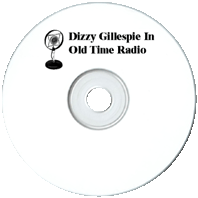

American jazz trumpeter, bandleader, composer, and singer.

6 old time radio show recordings
(total playtime 2 hours, 13 min)
available in the following formats:
1 MP3 CD
or
3 Audio CDs
Text on OTRCAT.com ©2001-2025 OTRCAT INC All Rights Reserved. Reproduction is prohibited.
Dizzy Gillespie
(1917 – 1993)

With his horn-rimmed glasses (similar to Buddy Holly's), bent horn, and bulging "bullfrog" cheeks, Gillespie was instantly recognizable to even to non-Jazz fans, but these "gimmicks" were not part of the act, rather they were simply part of what Dizzy needed to make music. His trademark bulging cheeks are the result of years blowing the trumpet, resulting in a condition which is also referred to as "glassblower's disease", the cheek muscles becoming distended from years of strain.
Gillespie's bent horn was the result of an accident backstage during a 1953 performance. The horn was resting on a trumpet stand, which is designed to protect the instrument. Nonetheless, when someone fell on the stand the entire bell of the horn was bent upward. After the accident, Dizzy blew a few notes and decided that the horn actually sounded better and the upward angle projected the sound over the audience so it better reached those in the back of the club.

Gillespie was listed as 4F during the War but was kept from working by the recording industry strike. While his audience was restricted, he helped Charlie Parker and others develop the Bebop style which took listeners by storm when new recordings began being made again. During the late 1950s, the State Department sent Gillespie on a series of tours through the Middle East and other regions as an "Ambassador of Jazz". He usually came back from these trips adding more world-influenced sound to his own material. In the early 1980s, Gillespie led the United Nations Orchestra.
Gillespie succumbed to pancreatic cancer on January 6, 1993, at the age of 75. A Star on the Hollywood Walk of Fame at 7057 Hollywood Blvd honors Dizzy Gillespie's contributions to recording.
Text on OTRCAT.com ©2001-2025 OTRCAT INC All Rights Reserved. Reproduction is prohibited.
You have reached the maximum number of votes for a unregistered user.
Please login or create a new account to continue...
You have reached the maximum number to down votes in this page.



Dizzy Gillespie Disc A001
|
Add Audio CD to Cart - $5.00 |
Dizzy Gillespie Disc A002
|
Add Audio CD to Cart - $5.00 |
Dizzy Gillespie Disc A003
|
Add Audio CD to Cart - $5.00 |
Please wait...
COMMENTS
Be the first to comment on "Dizzy Gillespie"
Leave a comment